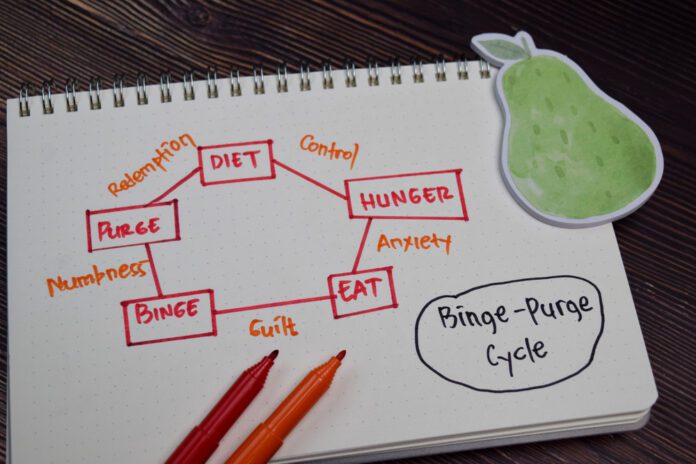Overview
Bulimia is an eating disorder in which a person has regular episodes of eating a very large amount of food (bingeing) during which the person feels a loss of control overeating. The person then uses different ways, such as vomiting or laxatives (purging), to prevent weight gain.
Many people with bulimia also have anorexia.
Cause
Many more women than men have bulimia. The disorder is most common in teenage girls and young women. The person usually knows that her eating pattern is abnormal. She may feel fear or guilt with the binge-purge episodes.
The exact cause of bulimia is unknown. Genetic, psychological, family, society, or cultural factors may play a role. Bulimia is likely due to more than one factor.
Symptoms
With bulimia, eating binges may occur as often as several times a day for many months. The person often eats large amounts of high-calorie foods, usually in secret. During these episodes, the person feels a lack of control overeating.
Binges lead to self-disgust, which causes purging to prevent weight gain. Purging may include:
- Forcing oneself to vomit
- Excessive exercise
- Using laxatives, enemas, or diuretics (water pills)
- Purging often brings a sense of relief.
- People with bulimia are often at a normal weight, but they may see themselves as being overweight. Because the person’s weight is often normal, other people may not notice this eating disorder.
Symptoms that other people can see include:
- Spending a lot of time exercising
- Suddenly eating large amounts of food or buying large amounts of food that disappear right away
- Regularly going to the bathroom right after meals
- Throwing away packages of laxatives, diet pills, emetics (drugs that cause vomiting), or diuretics
Exams & Tests
A dental exam may show cavities or gum infections (such as gingivitis). The enamel of the teeth may be worn away or pitted because of too much exposure to the acid in vomit.
A physical exam may also show:
- Broken blood vessels in the eyes (from the strain of vomiting)
- Dry mouth
- Pouch-like look to the cheeks
- Rashes and pimples
- Small cuts and calluses across the tops of the finger joints from forcing oneself to vomit
- Blood tests may show an electrolyte imbalance (such as low potassium level) or dehydration.
Treatment
People with bulimia rarely have to go to the hospital, unless they:
- Have anorexia
- Have major depression
- Need medicines to help them stop purging
- Most often, a stepped approach is used to treat bulimia. Treatment depends on how severe the bulimia is, and the person’s response to treatments:
- Support groups may be helpful for mild bulimia without other health problems.
- Counseling, such as talk therapy and nutritional therapy are the first treatments for bulimia that does not respond to support groups.
- Medicines that also treat depression, known as selective serotonin-reuptake inhibitors (SSRIs) are often used for bulimia. Combining talk therapy with SSRIs may help if talk therapy alone does not work.
People may drop out of programs if they have unrealistic hopes of being “cured” by therapy alone. Before a program begins, people should know that:
- Different therapies will likely be needed to manage this disorder.
- It is common for bulimia to return (relapse), and this is no cause for despair.
- The process is painful, and the person and their family will need to work hard.
Source
Courtesy of MedlinePlus from the National Library of Medicine



